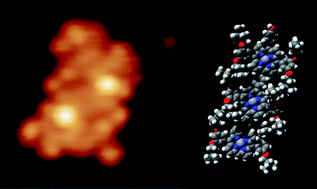Real-space characterization of hydroxyphenyl porphyrin derivatives designed for single-molecule devices
Abstract
Porphyrin derivatives are potential candidates as constituents of functional molecular devices because their electronic levels can be rationally manipulated by chemical modification. In this work, we deposit a porphyrin molecule with a hydroxyphenyl side group on Au(111), which is designed and synthesized as a basic unit for functional single molecule devices, and observe the bonding structure and electronic states with scanning tunneling microscopy (STM). The molecule changes configuration from a monomer to a cluster to a monolayer as the coverage increases, ruled by the H-bonding interaction through the hydroxyphenyl group and the steric repulsion by the isopentoxy groups. The highest occupied molecular orbital (HOMO) and the lowest unoccupied molecular orbital (LUMO) localized in the porphyrin macrocycle are observed at −1.1 and +1.1 eV, respectively, with respect to the Fermi level. We also deposit a para-phenylene-bridged porphyrin array on the surface using the electrospray method, and observe the local density of states along the array.


 Please wait while we load your content...
Please wait while we load your content...